Anti-aircraft guns against tanks. Part 2
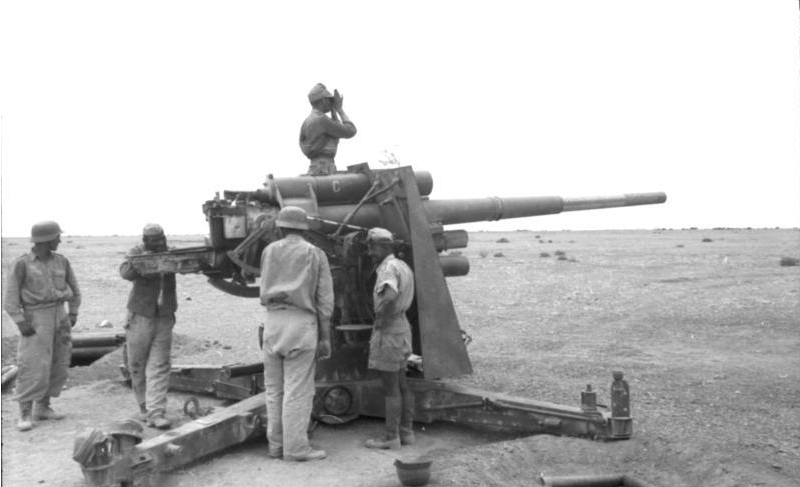
Germany
After the defeat of Germany in the First World War by the Versailles Treaty, it was forbidden to have and create anti-aircraft artillery, and the already built anti-aircraft guns were to be destroyed. In this regard, work on the design and implementation of new anti-aircraft guns in the metal was carried out in Germany secretly or through front companies in other countries. For the same reason, all the anti-aircraft guns, designed in Germany before 1933, had the designation “arr. 18. Thus, in the case of requests from representatives of England and France, the Germans could answer that these were not new tools, but old ones created during the First World War.
In the early 30s, due to a sharp increase in the combat characteristics aviation - the speed and range of flight, the creation of all-metal aircraft and the use of aviation armor, an acute question arose of covering troops from attacks by attack aircraft. Under these conditions, large-caliber machine guns and small-caliber anti-aircraft machine guns of 12,7–40 mm caliber, capable of effectively hitting rapidly moving low-flying air targets, proved to be in demand. Unlike other countries, in Germany they did not create large-caliber anti-aircraft machine guns, but concentrated their efforts on anti-aircraft guns (MZA) of 20-37-mm caliber.
In 1930, the Rheinmetall firm created a 20-mm anti-aircraft gun 2,0 cm FlaK 30 (German 2.0 cm Flugzeugabwehrkanone 30 - a 20-mm anti-aircraft gun of the 1930 model). The ammunition used for firing is known as 20 × 138 mm B or Long Solothurn. 20 × 138 mm B - means that the caliber of the projectile is 20 mm, the length of the sleeve was 138 mm, letter "B" indicates that this is an ammunition with a belt. Projectile weight 300 grams. This ammunition was widespread: in addition to the 2.0 cm FlaK 30, it was used in the 2.0 cm Flak 38 anti-aircraft gun, in tank KwK 30 and KwK 38 cannons, MG C / 30L aircraft cannon, S-18/1000 and S-18/1100 anti-tank guns.
Anti-aircraft gun 2,0 cm FlaK 30 in the version for ground forces mounted on the towed wheel carriage. Weight in the fighting position was 450 kg. Combat rate of fire - 120 – 280 rds / min, food was carried out from a round magazine on 20 shells. Aim range - 2200 meters.
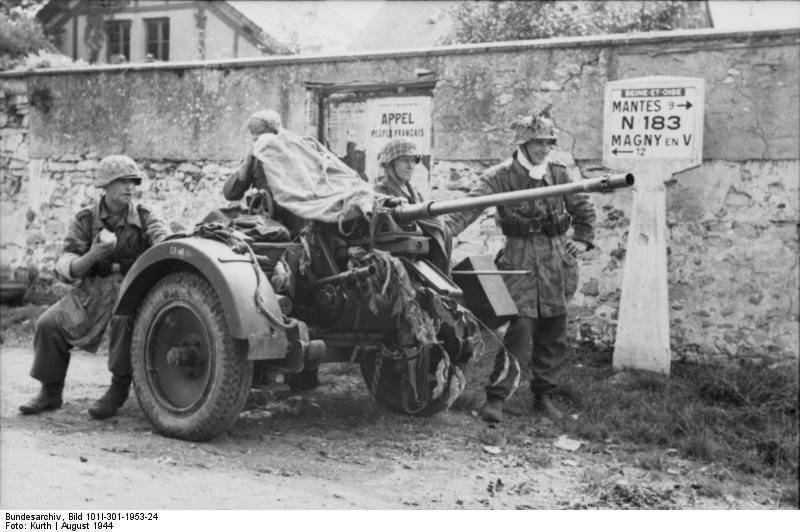
In the Wehrmacht guns began to come from the 1934 year, in addition, 20-mm Flak 30 were exported to Holland and China. This anti-aircraft gun had a rich combat history. The baptism of 20-mm anti-aircraft guns took place during the Spanish Civil War, which lasted from July 1936 to April 1939. 20-mm FlaK 30 were in the composition of the anti-aircraft units of the German Legion "Condor".
The F / 88 artillery unit consisted of four heavy batteries (88-mm guns) and two light (originally 20-mm guns, and later - 20-mm and 37-mm guns). Mostly ground targets were fired by 88-mm anti-aircraft guns, which had a long range and high destructive action of projectiles. But the Germans did not miss the opportunity to test the effectiveness of small-caliber machine guns when firing at ground targets. FlaK 30 was mainly used to bombard Republican positions and destroy firing points. It is not known whether they were used against tanks and armored vehicles, but given the fact that the maximum thickness of the T-26 armor was 15 mm, and the 20-mm armor-piercing incendiary tracer PzGr weighing 148 g gr 200 meters pierced the 20 mm armor, it can be considered that FlaK 30 represented a mortal danger for Republican armored vehicles.
According to the results of the combat use of 20-mm Flak 30 in Spain, Mauser carried out its modernization. The upgraded sample was called 2,0, see Flak 38. The new installation had the same ballistics and ammunition. The Flak 30 and Flak 38 had basically the same design, but the Flak 38 had a lower fighting weight on 30 kg and a significantly higher rate of fire, which was Xirm-220 rpm instead of Xnumx-Xnumx rpm for Flak-480. This determined its greater combat effectiveness when firing at air targets. Both cannons were mounted on a light wheeled carriage, which provided in a combat position a roundabout with the highest angle of elevation 120 °.
Before the beginning of the Second World War, each Wehrmacht infantry division was relied on 16 units. Flak 30 or Flak 38. The advantages of the 20-mm anti-aircraft guns were the simplicity of the device, the ability to quickly disassemble and assemble, and the relatively low weight, which made it possible to transport 20-mm anti-aircraft guns by conventional trucks or SdKfz 2 semi-tracked motorcycles at high speed. For short distances, anti-aircraft machines could easily roll by the forces of calculations.
There was a special collapsible "pack" version for mountain army units. In this version, the Flak 38 gun remained the same, but a compact and, accordingly, lighter carriage was used. The gun was called 2-cm by the mountain anti-aircraft gun Gebirgeflak 38 and was intended to destroy both air and ground targets.
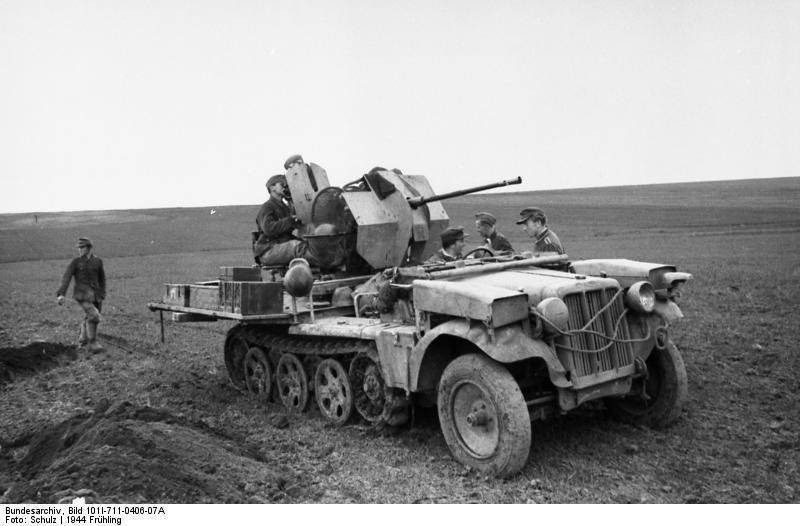
In addition to towed, it was created a large number of self-propelled guns. Trucks, tanks, various tractors and armored personnel carriers were used as chassis. To increase the density of fire on the basis of Flak-38, a quad unit 2-cm Flakvierling 38 was developed. The effectiveness of anti-aircraft installation was very high.
During battles in Poland and in France, 20-mm Flak 30 / 38 had to fire only a few times, reflecting enemy ground attacks. Quite predictably, they showed high efficiency against manpower and lightly armored vehicles. The most advanced serial Polish tank 7TP, which was, like the Soviet T-26, the British version of the Vickers 6-ton, was easily hit by 20-mm armor-piercing shells at real combat distances.
During the campaign of the German troops in the Balkans, which lasted 24 of the day (from 6 to 29 on April 1941 of the year), 20-mm anti-aircraft guns showed high efficiency when firing at the embrasures of long-term firing points.
In the domestic memoir and technical literature describing the course of hostilities in the initial period of the war, it is considered that the Soviet T-34 and KV tanks were completely invulnerable to the fire of German small-caliber artillery. Of course, 20-mm anti-aircraft guns were not the most effective anti-tank weapon, but several cases of destruction of medium T-34 and immobilization or disabling of weapons and surveillance devices of heavy HF were reliably recorded. Adopted in 1940, a sub-caliber projectile at a distance of 100 meters along the normal pierced the 40 mm armor. The long burst, released at close range, it was quite possible to “gnaw” the frontal T-34 armor. In the initial period of the war, quite a few of our tanks (first of all light) were hit by 20-mm projectiles. Of course, not all of them were fired from the barrels of anti-aircraft machine guns; similar weapons were also armed with German light tanks Pz.Kpfw. Ii. And taking into account the nature of the defeat, it is impossible to determine from what type of gun the projectile was launched.
In addition to the Flak-30 / 38, the 20-mm automatic machine 2.0 cm Flak 28 was used in smaller quantities in German air defense. This anti-aircraft gun conducts its lineage from the German "Becker gun", which was developed as early as the First World War. Firm "Oerlikon", so named by location - the suburbs of Zurich, acquired all the rights to develop a gun.
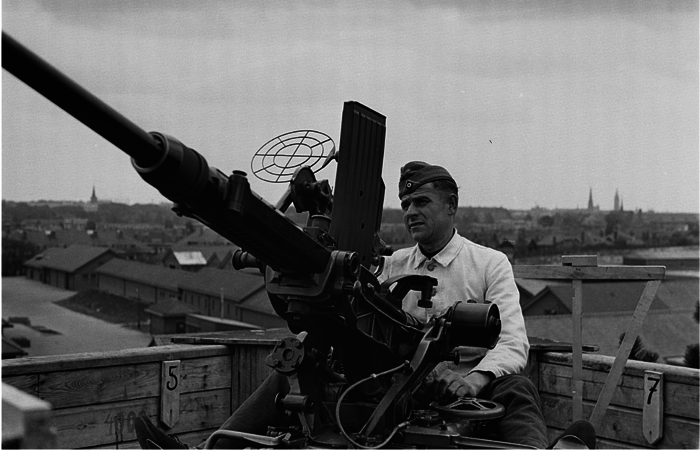
In Germany, the gun was widely used as a means of anti-aircraft defense, but there were also field versions of the gun, which were widely used in the Wehrmacht and Luftwaffe anti-aircraft forces under the designation 2.0 cm Flak 28 and 2 cm VKPL vz. 36. During the period from 1940 to 1944, Werkzeugmaschinenfabrik Oerlikon supplied 7013 20-mm cannons and 14,76 million projectiles to the armed forces of Germany, Italy and Romania. Several hundred such anti-aircraft guns were seized in Czechoslovakia, Belgium and Norway.
The scale of the use of 20-mm cannons is indicated by the fact that in May 1944, the ground forces had 6 355 cannons, and the parts of the Luftwaffe providing German air defense were more than 20000 20-mm cannons. If after 1942, the Germans used 20-mm guns for firing at ground targets quite rarely, by the middle of 1944, more and more small-caliber anti-aircraft guns were installed in stationary defensive positions, which was an attempt to compensate for the lack of other heavy weapons.
For all its merits, 20-mm anti-aircraft guns had a small armor penetration and their shells contained a tiny amount of explosive charge. In 1943, Mauser made the Flak 30 anti-aircraft gun 103 cm Flak 20 / 38 an anti-aircraft X-gun of the MK-3.0 X-gun and an anti-aircraft cannon. The action of the machine’s mechanisms was based on a mixed principle: the unlocking of the bore and cocking was done by the energy of the powder gases discharged through the side bore in the barrel, and the feed mechanisms were operated by the energy of the rolled back barrel. The new 103-mm unit had two-way tape power. Automation tools allowed to fire bursts with technical rate of fire 38 - 30 rds / min. Flak 360 / 420 is launched in 103 year. Total produced 38 gun. In addition to single-barreled, twin and quad 1944-mm units were produced in a small number.
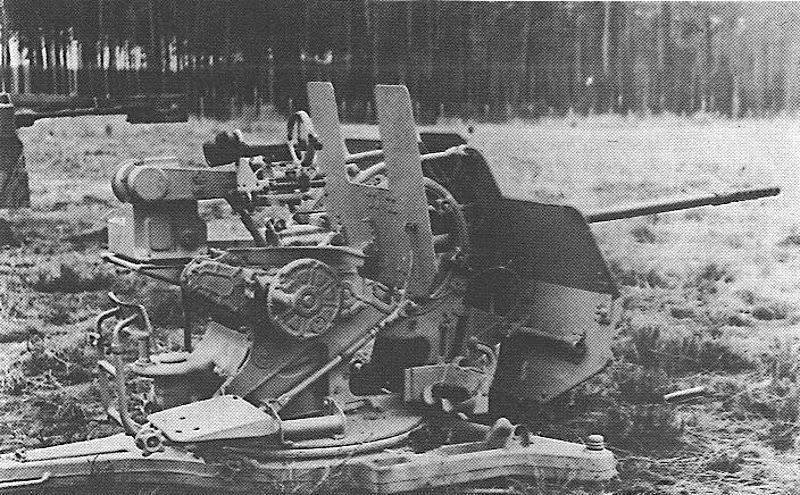
In 1943, the Waffen-Werke facility in Brunn based on the 30-mm air cannon MK 103 created an anti-aircraft automatic gun MK 303 Br. From Flak 103 / 38 it was distinguished by the best ballistics. For a projectile weighing 320 g, its initial velocity for the MK 303 Br was 1080 m / s versus 900 m / s for Flak 103 / 38. As a result, the MK 303 Br projectile had greater armor penetration. At a distance of 300 meters, an armor-piercing sub-caliber (BPS), named Hartkernmunition (German for hard-core ammunition), could penetrate 75 mm armor along the normal. However, in Germany during the war there was always an acute shortage of tungsten for the production of BPS. The 30-mm units were much more efficient than the 20-mm, but the Germans did not have time to develop a large-scale production of these anti-aircraft guns and they did not have a significant impact on the course of the hostilities.
In 1935, the 37-mm automatic anti-aircraft gun 3.7 cm Flak 18 entered service. Its development began at Rheinmetall in the 20s, which was an unconditional violation of the Versailles agreements. Automation anti-aircraft guns worked by the recoil energy in the short course of the barrel. The shooting was carried out from the thumb carriage, leaning with the help of a cruciform base on the ground. In the stowed position, the gun was mounted on a four-wheeled wagon. A significant drawback was the bulky four-wheeled carriage. It turned out to be heavy and clumsy, so it was replaced by a new four-carriage carriage with a separating two-wheeled course. The 37-mm anti-aircraft automatic cannon with the new two-wheeled gun carriage is called 3.7 cm Flak 36.
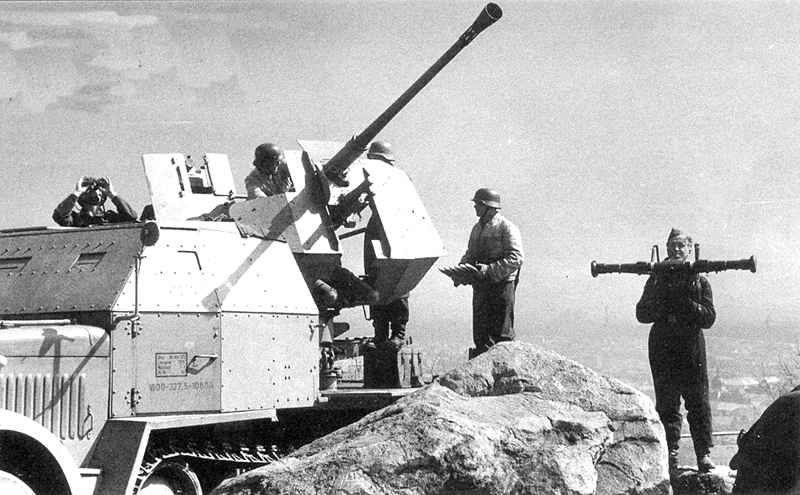
In addition to regular gun carriages, 1936, 37-mm Flak 18 and Flak 36 submachine guns were installed on various trucks and armored personnel carriers and on tank chassis. Production of Flak 36 and 37 was carried out until the very end of the war in three factories (one of them was in Czechoslovakia). In April, the 1945 of the Luftwaffe and the Wehrmacht had about 4000 37-mm anti-aircraft guns.
In 1943, on the basis of 3.7 cm Flak 36, Rheinmetall developed a new 37-mm 3.7 cm Flak 43 machine. The gun had a fundamentally new scheme of automation, when part of the operations was carried out at the expense of the energy of the exhaust gases, and partly at the expense of rolling away parts. The Flak 43 magazine accommodates 8 cartridges, while the Flak 36 has been designed for 6 cartridges. Flak 37 43-mm machines were installed on both single and vertically paired installations. In total, more than 20000 37-mm anti-aircraft guns of all modifications were built in Germany.
37-mm anti-aircraft guns had a good ability to combat armored vehicles. Armor-piercing shell model Pz.Gr. at a distance of 50 meters at the angle of the meeting 90 ° punched 50 mm armor. At a distance of 100 meters, this figure was 64 mm. At the end of the war, the enemy actively used 37-mm anti-aircraft guns to enhance the anti-tank capabilities of infantry units in the defense. Especially widely 37-mm machines were used at the final stage during street battles. Anti-aircraft guns were installed in fortified positions at key intersections and camouflaged in doorways. In all cases, the calculations sought to fire on the sides of the Soviet tanks.
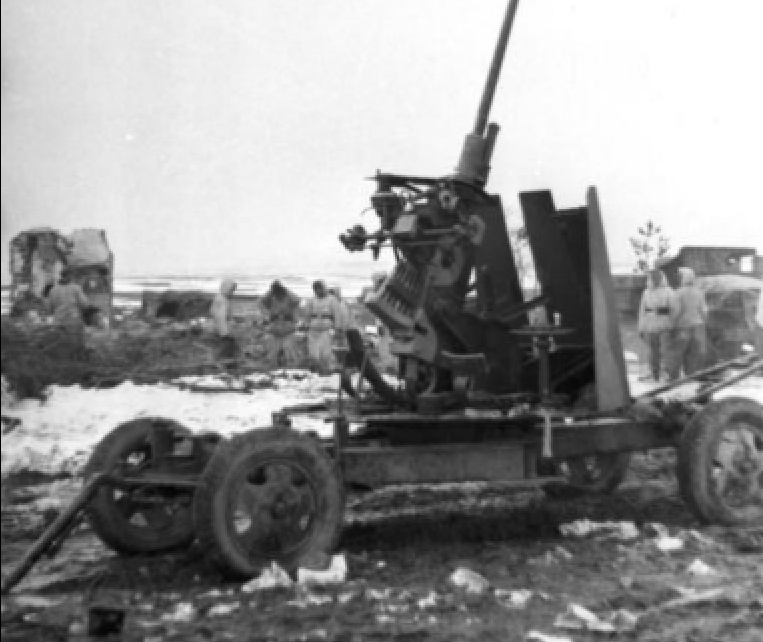
In addition to their own 37-mm anti-aircraft guns, in Germany there was a significant number of captured Soviet 37-mm 61-K and Bofors L60. Compared with German-made anti-aircraft guns, they were much more often used for firing at ground targets, as they often did not have anti-aircraft centralized control devices and were used by German troops not as standard weapons.
Medium-caliber anti-aircraft guns have been designed in Germany since the middle of the 20's. In order not to give rise to accusations of violating the Versailles agreements, the designers of the Krupp company worked in Sweden, in agreement with the Bofors company.
At the end of 20's, Rheinmetall created 75-mm 7.5 cm Flak L / 59 anti-aircraft guns, which also did not suit the German military and was later proposed by the USSR as part of military cooperation. It was quite a modern weapon with good ballistic characteristics. Its carriage with four folding beds provided circular fire, with a weight of 6,5 kg, the vertical firing range was 9 km.
In 1930, the 75 cm Flak L / 7.5 anti-aircraft 60-mm anti-aircraft gun with a semi-automatic shutter and a cruciform platform began. This anti-aircraft gun in the German armed forces was not officially accepted into service, but was actively produced for export. In 1939, unrealized samples were requisitioned by the German Navy and used in coastal defense units.
In 1928, the designers of the firm Friedrich Krupp AG began designing the 88-mm anti-aircraft gun in Sweden using 7.5 cm Flak L / 60 elements. Later, the design documentation was secretly delivered to Essen, where they produced the first prototypes of anti-aircraft guns. The prototype was tested in 1931 year, but the mass serial production of 88-mm anti-aircraft guns began after Hitler came to power. So there was the famous acht-acht (8-8) - from the German Acht-Komma-Acht Zentimeter - centimeter 8,8 - 88-mm anti-aircraft gun.
For its time, it was a very perfect tool. It is recognized as one of the best German guns of World War II. The 88-mm anti-aircraft gun had very high characteristics for that time. A fragmentation projectile with a mass of 9 kg could hit targets at an altitude of 10600 m, the horizontal flight range was 14800 m. The mass of the gun in the combat position was 5000 kg. Rate of fire - up to 20 rds / min.
The gun, which received the designation 8.8 сm Flak 18, passed "baptism of fire" in Spain, where it was often used against ground targets. The power of the 88-mm anti-aircraft guns was abundantly enough to “disassemble any tank or armored car that the Republicans had for spare parts”.
The first combat episodes of 8.8 with m Flak 18 are recorded in 1937 year. Since there were practically no decent targets for these powerful guns in the air, the destruction of ground targets became their main task at that time. After the fighting in the north of Spain, five anti-aircraft artillery batteries were concentrated in the vicinity of Burgos and Santander. During the offensive of the Republican forces near Terualem, two F / 88 batteries were used to defend Burgos, Almazany and Zaragossa. In March, 1938, two batteries supported by fire the actions of the Francoists in the Villaneva de Heva district. At the same time, anti-aircraft guns were successfully used to suppress Republican artillery batteries.
The combat experience gained in Spain was subsequently taken into account when creating upgraded samples of 88-mm caliber anti-aircraft guns. The most notable innovation was a shield to protect against bullets and shrapnel. Based on the experience gained during operation in the troops and in the course of hostilities, the gun was modernized. Modernization mainly affected the design of the trunk, developed by Rheinmetall. The internal structure of both trunks and ballistics were the same. The upgraded 88-mm gun (8.8 сm Flak 36) entered service in the 1936 year. Later the gun was modified in 1939 year. The new sample was named 8.8 with m Flak 37. Most of the nodes of guns arr. 18, 36 and 37 were interchangeable.
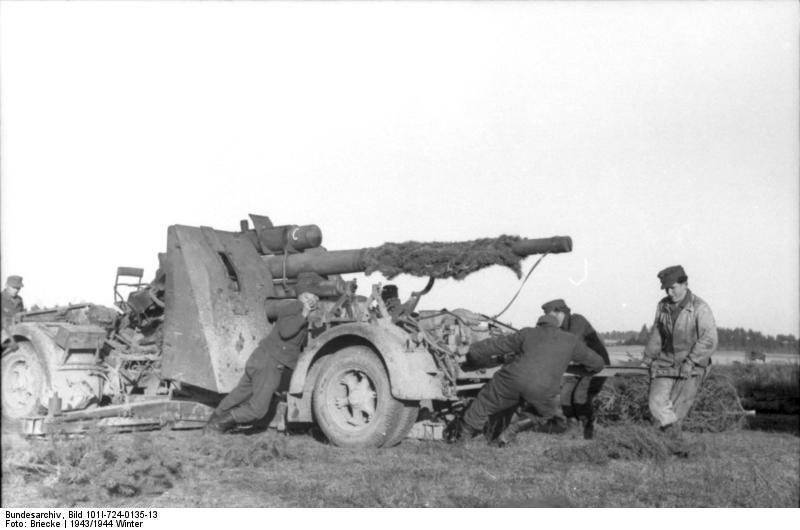
Modifications of the Flak 36 and 37 guns differed mainly in the mast design. The Flak 18 was transported on a lighter Sonderaenhanger 201 wheeled cart, so it weighed almost 1200 kg more easily in the stowed position than the later modifications carried on the Sonderaenhanger 202.
In 1941, Rainmetal manufactured the first prototype of a new 88-mm gun, designated 8.8 сm Flak 41. This gun was adapted for firing ammunition with enhanced propelling charge. The new gun had a rate of fire of 22-25 shots per minute, and the initial velocity of the fragmentation projectile reached 1000 m / s. The gun had a swivel-type carriage with four cruciform beds.
88-mm guns became the most numerous heavy anti-aircraft guns of the III Reich. In the middle of 1944, the German army deployed more than 10 000 of such guns. 88-mm anti-aircraft guns were arming anti-aircraft battalions of tank and grenadier divisions, but more often these weapons were used in the anti-aircraft parts of the Luftwaffe, which were part of the Reich air defense system. With success 88-mm guns were used to fight the enemy tanks, and also acted as field artillery. 88-mm anti-aircraft gun served as a prototype tank gun for the "Tiger".
At the beginning of World War II, during the Polish campaign, heavy anti-aircraft batteries armed with Flak 18 / 36 cannons were used very little for their intended purpose. MZA caliber 20-mm and 37-mm coped well with Polish aircraft at low altitudes, providing effective protection to their troops. For all the time of the campaign in Poland, heavy anti-aircraft batteries bombarded Polish aircraft only a few times, but they were widely attracted to destroy ground targets. In some cases, the calculations of anti-aircraft guns, located in the advanced combat order of the German troops, had to engage in hand-to-hand combat with counterattacking Poles. Eighteen anti-aircraft batteries concentrated around Warsaw took part in the shelling of the Polish capital. Batteries 88-mm guns supported and the actions of the German infantry during the battle of Bzur.
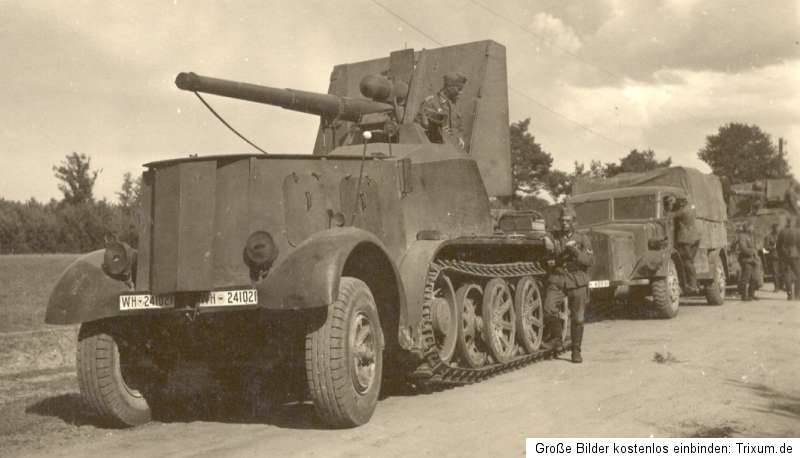
The 8.8 cm Pak 18 self-propelled guns on the chassis of the Zugkraftwagen 12-ton tractor showed themselves very well when firing ground targets. Considering the fact that the SAU reservation was weak, they changed positions after 2-3 shots and the Polish gunners simply did not have time to detect them. 10 SAU were in the 8-th separate heavy artillery anti-tank battalion (Panzer-Jager Abteilung 8). Production of self-propelled guns of this type was limited to 25 units, since the chassis was considered not very successful.
In the spring of 1940, this division was attached to the 2 Tank Division, which was part of the 19 Corps under the command of General Heinz Gudarin. Self-propelled gun also showed itself well in France. 13 May 1940 of the SAU 8.8 cm Pak 18 were used to combat the enemy's long-term firing points on the Meuse River. 88-mm anti-aircraft guns successfully coped with their task, suppressing the resistance of the French pillboxes, which made the French soldiers in this area capitulate. Self-propelled guns went through the entire campaign, successfully applied to combat French tanks. Later they took part in the invasion of the Soviet Union. The last of the SAU of this type were lost in the USSR in March 1943 of the year. Subsequently, the Germans widely installed 88-mm anti-aircraft guns on various semi-tracked and tracked chassis. These machines were used as ACS and ZSU.
On a much larger scale than the ACS, towed anti-aircraft guns were used in France. For example, 22 in May 1940 of the 88-mm cannon from the 1-th division of the anti-aircraft regiment (Flak Lehr Regiment) fired heavy B1 bis tanks from the French 1-th tank division from close range. For several minutes, 7 tanks were hit. Two days earlier, a large group of tanks from the 29 th Dragoon Regiment and the 39 Tank Battalion fell into an ambush set up by the gunners of the 1 Battalion of the Hermann Gering anti-aircraft artillery regiment. The 88-mm anti-aircraft guns easily pierced the frontal armor of both the French B1 bis Char and the British Matilda Mk I.
The acht-acht cannon became for the Germans a real “magic wand”, effective both in air defense and against ground targets. During the campaign in the West 1940, the gunners of the 1 anti-aircraft corps destroyed on the ground: 47 tanks and 30 pillboxes. The 2 th anti-aircraft corps, supporting the actions of the 4 and 6 armies, hit the 284 tank, destroyed the 17 bunkers.
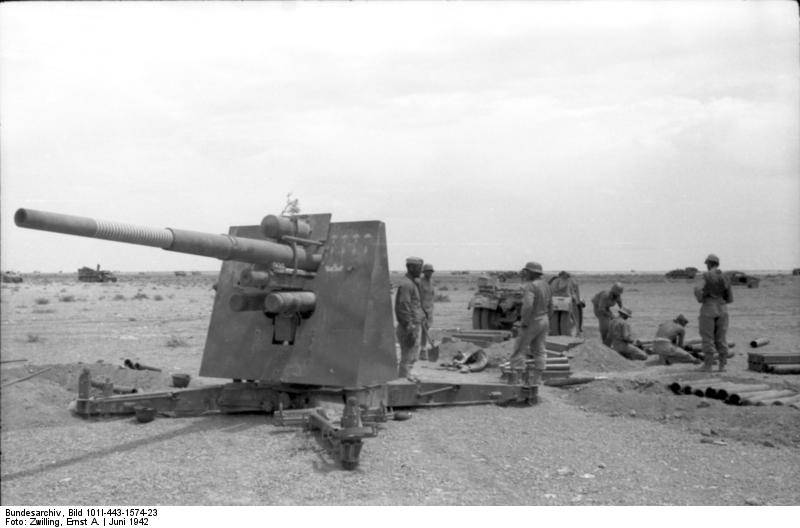
During the African campaign, the 88-mm anti-aircraft flak 18 / 36, available in the German African Corps, proved to be a lethal anti-tank tool, largely devaluing the British superiority in the number and quality of tanks. Rommel's troops who arrived in Africa had only 37-mm Cancer-36 / 37 anti-tank guns, T-II tanks with 20-mm gun, T-III with 37-mm gun and T-IV with 75-mm short-barreled gun. The British had well-armored Krusader, Matilda, Valentine tanks, low-vulnerable for German tank and anti-tank guns. Therefore, the 88-mm anti-aircraft guns for the German troops were the only effective means of fighting enemy tanks.
Rommel originally had 24 Flak 18 / 36, but they managed to make a big impact on the course of the fighting. The guns were placed in hiding places and well disguised, which was an unpleasant surprise for British tankers. The Matild Attack of the 2nd 4 Tank Brigade ended in disaster for the British, 15 from 18 tanks was lost. In the trap that Rommel created by placing his 88-mm cannons near the pass, rightly called by the English soldiers “hellfire pass”, only one of the 13 tanks “Matilda” survived. ” After only two days of fighting in early June 1941, the British lost the 64 tank "Matilda". At the beginning of the African campaign, 88-mm anti-aircraft guns were installed in well-fixed stationary firing positions, later they were increasingly used in maneuvering operations, often firing directly from the wheels in the transport position. With this method of shooting accuracy decreased slightly, but the time of coagulation-deployment decreased many times. Using the features of the North African theater, German troops actively used 88-mm guns during offensive operations. Before the attack, the guns secretly advanced to the front and, during a tank attack, supported their vehicles with fire. In this case, British tanks were shot from a distance at which their return fire was ineffective.
In 1941, the only German artillery systems capable of penetrating the armor of Soviet KV heavy tanks were 88-mm anti-aircraft guns, if you don’t take case artillery into account, of course. During the war, 88-mm towed anti-aircraft guns were actively used to fight Soviet, British and American tanks on all fronts. Especially their role in the VET increased after the transition of the German troops to a strategic defense. Until the second half of the 1942 year, when the number of 88-mm guns at the front edge was relatively small, they did not hit so many T-34 and KV tanks (3,4% - 88-mm guns). But in the summer of 1944, the 88-mm guns accounted for up to 38% of wounded Soviet medium and heavy tanks, and with the arrival of our troops in Germany in the winter - in the spring of 1945, the percentage of wrecked tanks ranged from 50 to 70% (on different fronts). Moreover, the greatest number of tanks was hit at a distance of 700 - 800 m. These data are given for all 88-mm guns, but even in 1945, the number of 88-mm anti-aircraft guns significantly exceeded the number of 88-mm anti-tank guns of special construction. Thus, at the last stage of the war, German anti-aircraft artillery played a significant role in land battles.
The 8.8 anti-aircraft guns with m Flak 18 / 36 / 37 / 41 were very effective against any tank that participated in World War II. Flak 41 stood out in particular in this regard. At a distance of 1000 meters, a caliber armor-piercing projectile Panzergranate 39-1, weighing 10,2 kg, fired from the barrel of this gun at a speed of 1000 m / S, normalized through 200 mm armor. Reliable protection against its fire was realized only in the Soviet IS-3 heavy tank, which did not have time to take part in hostilities. The EC-2 of the 1944 model of the year was the best in durability against 88-mm guns among the fighting machines. In the general statistics on the irretrievable loss of heavy tanks EC-2, the losses from 88-mm guns are about 80% of cases. Any other serial tank of the USSR, USA or Great Britain did not provide its crew with any kind of protection against 88-mm anti-aircraft guns at all.
In 1938, the 105-mm anti-aircraft gun 10.5 cm Flak 38 was adopted. Initially, it was developed as a ship's universal anti-aircraft gun. The gun had a semi-automatic wedge bolt. Semiautomatic mechanical type cocked when reeling. The 10.5 cm Flak 38 gun originally had electro-hydraulic pointing drives identical to the Flak 8,8 and 18 36-cm, but the 1936 introduced the UTG 37 system used on the Flak 8,8 gun. At the same time, a free-tube barrel was introduced. The system thus upgraded was given the name 37 сm Flak 10.5. Both types differed mainly in the structure of the carriage. The initial velocity of the fragmentation projectile weighing 39 kg was 15,1 m / s, the armor-piercing mass 880 kg - 15,6 m / s. The armor penetration of the gun at a distance of 860 meters - 1500 mm. Rate of fire - up to 138 rds / min.
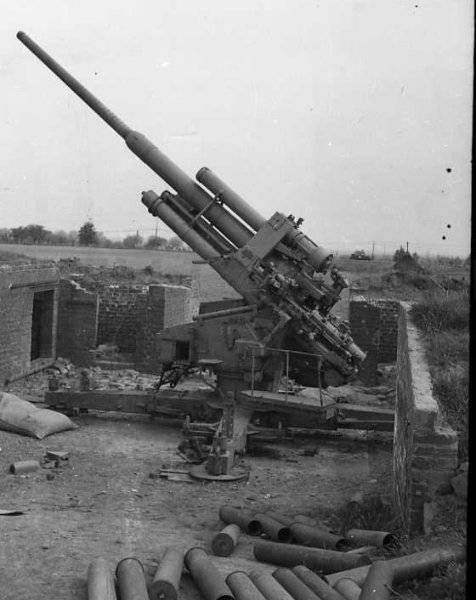
The guns were in production throughout the war. Due to the large mass that made up the 14600 kg in the stowed position, the gun was mainly used in the Reich air defense system, they covered industrial facilities and krigsmarine bases. In August, 1944, the number of 105-mm anti-aircraft guns reached a maximum. At that time, the Luftwaffe had 116 cannons placed on railway platforms, 877 cannons mounted stationary on concrete bases and 1025 cannons equipped with conventional wheel carriages. Until 1944, they were practically not used against tanks. The situation changed after the Red Army entered the territory of Germany. Due to the extremely low mobility of 105-mm anti-aircraft guns were located as an anti-tank reserve in advance positions in the depth of defense, in case of a breakthrough of Soviet tanks. On real combat distances, the 105-mm anti-aircraft gun could destroy any tank with a single shot. But because of the large mass and size of a large role, they did not play. Only 105-mm shells were hit no more than 5% of medium and heavy tanks. The 105-mm guns with a firing range at ground targets over 17000 meters were of much greater value in the case of counter-battery combat.
In 1936, the company Rheinmetall began work on the creation of 128-mm anti-aircraft guns. Prototypes were presented for testing at 1938. In December, the first order for 1938 installations was given to 100. At the end of 1941, the troops received their first batteries with 128-mm 12,8-cm Flak 40 anti-aircraft guns. This automation system was characterized by a high degree of automation. Guidance, supply and delivery of ammunition, as well as the installation of the fuse were made using four three-phase asynchronous electric motors with voltage 115 B.
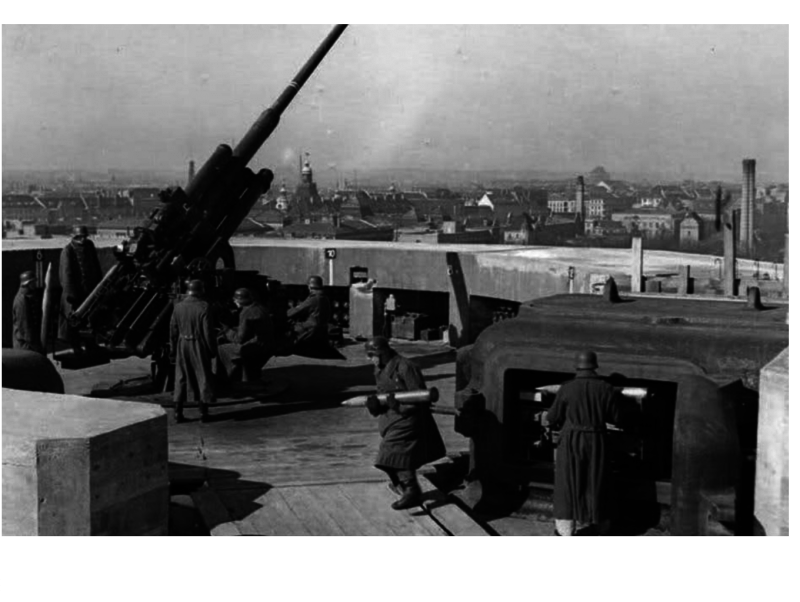
128-mm guns 12,8 cm Flak 40 were the heaviest anti-aircraft guns used during the Second World War. With a mass of fragmentation projectile 26 kg, which had an initial speed of 880 m / s, the height reachability was more than 14000 m.
Anti-aircraft guns of this type were received in parts of the crigsmarine and the Luftwaffe. They were mainly installed on stationary concrete positions, or on railway platforms. Initially, it was assumed that mobile 12,8-cm installations would be transported on two wagons, but later it was decided to restrict one to a four-axle wagon. During the war, only one mobile battery (six guns) entered service. By virtue of stationary placement in the fight against tanks, these guns did not participate.
Among the Soviet weapons, which fell into the hands of the Germans, was a large number of anti-aircraft guns. Since these guns were practically new, the Germans readily used them. All 76,2 and 85-mm guns were recalibrated to 88-mm so that you can use the same type of ammunition. By August 1944, the German army had 723 cannons Flak МЗ1 (r) and 163 cannons Flak М38 (r) cannons. The number of these guns captured by the Germans is not precisely known, but it can be said that the Germans had a significant number of these guns. For example, the Daennmark anti-aircraft artillery corps counted 8 batteries on 6-8 such guns, about twenty similar batteries were located in Norway. In addition, the Germans used a relatively small number of other foreign medium-caliber anti-aircraft guns. The most widely used are the Italian 7.5 cm Flak 264 (i) and 7.62 cm Flak 266 (i) cannons, as well as the Czechoslovak 8.35 cm Flak 22 (t) cannons. After the capitulation of Italy, a large number of Italian weapons turned out to be at the disposal of the German troops. In the 1944, the service in the German army was at least 250 90-mm Italian anti-aircraft guns, called 9 cm Flak 41 (i). It is safe to say that some of these trophy anti-aircraft guns were used in the battles of the final stage of the war against our tanks and allied tanks.
In the course of the war, German anti-aircraft guns of medium and large caliber, in addition to their intended purpose, proved to be an excellent anti-tank weapon. Although they cost significantly more than specialized anti-tank guns and were used for lack of the best, the anti-aircraft guns available in the anti-aircraft battalions of tank and grenadier divisions and in the anti-aircraft units of the Luftwaffe had a noticeable effect on the course of the hostilities.
To be continued ...
Based on:
http://www.xliby.ru/transport_i_aviacija/tehnika_i_vooruzhenie_2000_11_12/p8.php
http://domfaktov.ru/poznavatelno/armija-i-flot/voennaja-tehnika/nemeckie-88-mm-zenitki-flak-18-36-37.html
Information